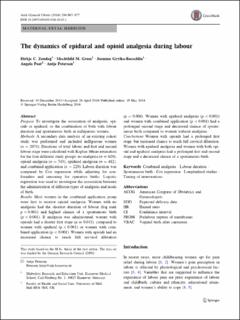Please use this identifier to cite or link to this item:
https://doi.org/10.21256/zhaw-4281Full metadata record
| DC Field | Value | Language |
|---|---|---|
| dc.contributor.author | Zondag, Dirkje C. | - |
| dc.contributor.author | Gross, Mechthild Maria | - |
| dc.contributor.author | Grylka-Baeschlin, Susanne | - |
| dc.contributor.author | Poat, Angela | - |
| dc.contributor.author | Petersen, Antje | - |
| dc.date.accessioned | 2018-07-16T12:44:03Z | - |
| dc.date.available | 2018-07-16T12:44:03Z | - |
| dc.date.issued | 2016 | - |
| dc.identifier.issn | 0932-0067 | de_CH |
| dc.identifier.issn | 1432-0711 | de_CH |
| dc.identifier.uri | https://digitalcollection.zhaw.ch/handle/11475/8159 | - |
| dc.description | Erworben im Rahmen der Schweizer Nationallizenzen (http://www.nationallizenzen.ch) | de_CH |
| dc.description.abstract | Purpose: To investigate the association of analgesia, opioids or epidural, or the combination of both with labour duration and spontaneous birth in nulliparous women. Methods: A secondary data analysis of an existing cohort study was performed and included nulliparous women (n = 2074). Durations of total labour and first and second labour stage were calculated with Kaplan-Meier estimation for the four different study groups: no analgesia (n = 620), opioid analgesia (n = 743), epidural analgesia (n = 482), and combined application (n = 229). Labour duration was compared by Cox regression while adjusting for confounders and censoring for operative births. Logistic regression was used to investigate the association between the administration of different types of analgesia and mode of birth. Results: Most women in the combined application group were first to receive opioid analgesia. Women with no analgesia had the shortest duration of labour (log rank p < 0.001) and highest chance of a spontaneous birth (p < 0.001). If analgesia was administered, women with opioids had a shorter first stage (p = 0.018), compared to women with epidural (p < 0.001) or women with combined application (p < 0.001). Women with opioids had an increased chance to reach full cervical dilatation (p = 0.006). Women with epidural analgesia (p < 0.001) and women with combined application (p < 0.001) had a prolonged second stage and decreased chance of spontaneous birth compared to women without analgesia. Conclusions: Women with opioids had a prolonged first stage, but increased chance to reach full cervical dilatation. Women with epidural analgesia and women with both opioid and epidural analgesia had a prolonged first and second stage and a decreased chance of a spontaneous birth. | de_CH |
| dc.language.iso | en | de_CH |
| dc.publisher | Springer | de_CH |
| dc.relation.ispartof | Archives of Gynecology and Obstetrics | de_CH |
| dc.rights | Licence according to publishing contract | de_CH |
| dc.subject | Combined analgesia | de_CH |
| dc.subject | Cox regression | de_CH |
| dc.subject | Labour duration | de_CH |
| dc.subject | Longitudinal studies | de_CH |
| dc.subject | Spontaneous birth | de_CH |
| dc.subject | Timing of interventions | de_CH |
| dc.subject | Pregnancy | de_CH |
| dc.subject.ddc | 618.4: Geburt | de_CH |
| dc.title | The dynamics of epidural and opioid analgesia during labour | de_CH |
| dc.type | Beitrag in wissenschaftlicher Zeitschrift | de_CH |
| dcterms.type | Text | de_CH |
| zhaw.departement | Gesundheit | de_CH |
| zhaw.organisationalunit | Institut für Hebammenwissenschaft und reproduktive Gesundheit (IHG) | de_CH |
| dc.identifier.doi | 10.21256/zhaw-4281 | - |
| dc.identifier.doi | 10.1007/s00404-016-4110-1 | de_CH |
| dc.identifier.pmid | 27194036 | de_CH |
| zhaw.funding.eu | No | de_CH |
| zhaw.issue | 5 | de_CH |
| zhaw.originated.zhaw | Yes | de_CH |
| zhaw.pages.end | 977 | de_CH |
| zhaw.pages.start | 967 | de_CH |
| zhaw.publication.status | publishedVersion | de_CH |
| zhaw.volume | 294 | de_CH |
| zhaw.embargo.end | 2021-12-01 | de_CH |
| zhaw.publication.review | Peer review (Publikation) | de_CH |
| Appears in collections: | Publikationen Gesundheit | |
Files in This Item:
| File | Description | Size | Format | |
|---|---|---|---|---|
| 2016_Gross_TheDynamicsOfEpiduralAndOpioid.pdf | 484.16 kB | Adobe PDF |  View/Open |
Show simple item record
Zondag, D. C., Gross, M. M., Grylka-Baeschlin, S., Poat, A., & Petersen, A. (2016). The dynamics of epidural and opioid analgesia during labour. Archives of Gynecology and Obstetrics, 294(5), 967–977. https://doi.org/10.21256/zhaw-4281
Zondag, D.C. et al. (2016) ‘The dynamics of epidural and opioid analgesia during labour’, Archives of Gynecology and Obstetrics, 294(5), pp. 967–977. Available at: https://doi.org/10.21256/zhaw-4281.
D. C. Zondag, M. M. Gross, S. Grylka-Baeschlin, A. Poat, and A. Petersen, “The dynamics of epidural and opioid analgesia during labour,” Archives of Gynecology and Obstetrics, vol. 294, no. 5, pp. 967–977, 2016, doi: 10.21256/zhaw-4281.
ZONDAG, Dirkje C., Mechthild Maria GROSS, Susanne GRYLKA-BAESCHLIN, Angela POAT und Antje PETERSEN, 2016. The dynamics of epidural and opioid analgesia during labour. Archives of Gynecology and Obstetrics. 2016. Bd. 294, Nr. 5, S. 967–977. DOI 10.21256/zhaw-4281
Zondag, Dirkje C., Mechthild Maria Gross, Susanne Grylka-Baeschlin, Angela Poat, and Antje Petersen. 2016. “The Dynamics of Epidural and Opioid Analgesia during Labour.” Archives of Gynecology and Obstetrics 294 (5): 967–77. https://doi.org/10.21256/zhaw-4281.
Zondag, Dirkje C., et al. “The Dynamics of Epidural and Opioid Analgesia during Labour.” Archives of Gynecology and Obstetrics, vol. 294, no. 5, 2016, pp. 967–77, https://doi.org/10.21256/zhaw-4281.
Items in DSpace are protected by copyright, with all rights reserved, unless otherwise indicated.